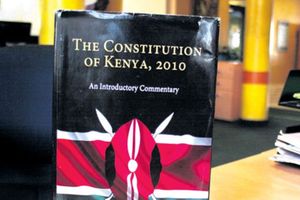
Police officers arrest peaceful protesters along Kimathi Street in Nairobi on August 8, 2024 during the Nane nane nationwide protests.
The youth-led anti-government protests in Kenya may have inspired a wave of similar protests across the world, including Bangladesh over 6,400 kilometers away. In Bangladesh, Gen Z protesters stormed the Ganabhaban (“People’s House”) and ousted Prime Minister Sheikh Hasina on August 5, 2024. In contrast, the agenda of Kenya’s Gen Z revolt appears to be a dream deferred after the police effectively contained the Nane Nane (August 8) protests.
Like the Kenya Government, the West wanted to see the Gen Z revolt brought to heel fast — and at all costs. The reason is simple. Kenya is too important to be left to Kenyans. “We cannot stand by and watch as Kenya goes down like Sri Lanka in 2022 or Bangladesh this week. A lot is at stake here. Something got to be done”, said one western colleague.
For nearly 70 years between 1895 and 1963, Kenya was considered a “White Man’s Country.” Like Zimbabwe and South Africa (British), Algeria (French) and Namibia (Germans), Kenya was a special colony, a jewel in the crown of British empire and increasingly the entire West.
Kenya’s special place in the imagination of the West is exemplified by America’s response to critical transitions over the last six decades. At the height of the Cold War in the heady 1960s, America dispatched William Attwood as ambassador to ensure that Kenya was on an even keel as a pro-West nation. The spill-the-beans US diplomat published the controversial autobiography: The Reds and the Blacks: A Personal Adventure (1967). As the Cold War ended, America sent another journalist, Smith Hempstone, as ambassador in the crucial 1989-1993 hiatus. His memoir, the Rogue Ambassador: An African Memoir (1997) reveals his mission in Kenya as that of pushing for multiparty elections and liberal democracy in one-party Kenya. And in the 21st century characterized by American geopolitical competition with China, in 2022 Washington sent Margaret (Meg) Whitman, the American business executive and billionaire (worth a modest $3.4 billion) as the United States ambassador to Kenya to roll back Chinese growing economic footprint and make American capital and Western financial Institutions influential again in Kenya.
Peacefully assembling
But how exactly was the Gen Z movement humbled? Two strategies are discernible. One, all genres of violence were used to prevent the youth from peacefully assembling, including the use of non-uniformed armed officers, infiltration of their movement by hired goons, abductions and killings. As a result, more than 55 protesters have died and many more abducted since the demonstrations started in June, according to the state-funded Kenya National Commission on Human Rights.
Two, to bring the Gen Z to heel, Kenya and its partners in the West appears to have resorted to the well-known ‘Opposition Strategy.
The West’s opposition strategy first appeared in the African Report by the International Crisis Group (ICG) titled: Zimbabwe: An Opposition Strategy, (N°117, August 24, 2006). The script of this strategy was tried in Zimbabwe and Kenya in 2008. One of the elements of the strategy the creates and supports an opposition leader often with a larger-than-life persona — exemplified by two friends, Raila Odinga in Kenya and Morgan Tsvangirai in Zimbabwe. The second strand is to unify the opposition and civil society to form a super opposition movement with huge political capacity. Third is to push the government to share power with the opposition in a transitional government, giving western actors the control the levers of policy-making in the government. In a word, the “Opposition Strategy” ensures that both the opposition and the government are safe for the West. It is a perfect neo-colonial tool.
The Gen Z movement challenged the West’s opposition strategy. It has, therefore, been seen as a potential cause of instability and an existential threat to Western interests.
The Gen Z movement registered quick victories in June. President Ruto withdrew the contentious Finance Bill 2024; sacked his entire cabinet and promised to form a new “broad-based” Government. Former Inspector General of Police, Japhet Koome, resigned after being widely accused of extreme brutality against peaceful protesters. But these gains were quickly rolled back. Dr. Ruto reappointed six CSs in the old cabinet and gave four posts to the opposition, including the powerful finance and energy ministries. Paradoxically, while anger over the new cabinet appointments were part of the reason for the Nane Nane protests, the broad-based government succeeded in confining the protests to Nairobi and its environs. Major towns and cities such as Kisumu (Raila’s hometown), Eldoret (Ruto's city) and Mombasa (home of newly appointed opposition CSs, Ali Joho and Opiyo Wandayi) that previously witnessed protests remained calm. This enabled the government to mobilise enough police officers, to contain protests in the Capital City. Although Nane Nane protests organisers hoped to bring five million Kenyans into the capital, the use of tear gas, mounting roadblocks on major roads and to disperse protesters and mass arrests barred protesters from accessing the central business district.
Heavy security was deployed at State House where the new cabinet was sworn in and protesters had threatened to storm.
The onus is now on the government to address the issues raised by the youth. So far, Kenya is a perfect dialogue of the deaf. The government is focused on its détente with the Raila wing of the opposition as an “alliance of rivals.” But Kenya’s young protesters have dismissed the new cabinet as merely perpetuating deal-making among the political elite, ignoring serious governance issues they have raised.
Kenya is no longer at ease. Its young people have vowed to continue demonstrating for the justice of those killed or abducted and “until the president steps down”. In the corridors of diplomacy, on August 8, the United States warned that it will not accept any further abductions and killing of innocent protestors, calling for immediate action against human rights violations.
For now the dreams of the Kenyan youth may have been deferred, but not for too long.
Professor Peter Kagwanja is former Government Adviser and currently the Chief Executive at the Africa Policy Institute. Kagwanja is also the author of Killing the vote : state sponsored violence and flawed elections in Kenya. A Kenya human rights commission report (Nairobi: Kenya Human Rights Commission (KHRC), 1998).













